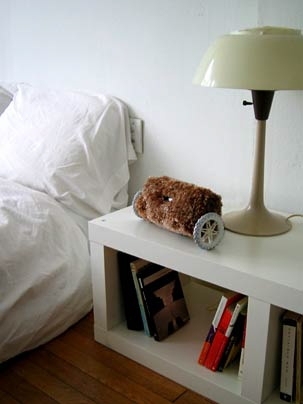A relatively simple product designed to combat a common problem is turning Media Arts and Science graduate student Gauri Nanda into a celebrity.
Working to solve the main cause of oversleeping--the snooze bar--Nanda has designed an early morning hide-and-seek process that could revolutionize the morning for many oversleepers.
Clocky--a shag-carpeting-covered digital clock on two wheels--jumps from the bedside table to find a hiding spot each time the snooze bar is pressed. A few minutes later, when the alarm sounds for a second time, the sleeper must first find the clock before he or she can press snooze again. Its designed to force people up and out of bed, making them less likely to keep snoozing.
Nanda created Clocky last semester in an industrial design class, but news of her invention started to spread just recently. After a blogger linked to Nanda's site, Clocky--and its creator--suddenly became media darlings. Clocky is scheduled to make an appearance on "Good Morning America" next week and has been profiled in dozens of newspapers across the country.
"People from all over the place are offering to beta-test it," said Nanda, who is currently working on patenting Clocky.
"Clocky is representing a story people understand," said Principal Research Scientist Michael Bove of the Media Lab. Bove is Nanda's advisor and the director of the CELab, the Media Lab's consumer electronics research program, whose goal is to create "simple, ubiquitous, easy- and delightful-to-use devices."
Bove has been overwhelmed by the amount of attention bestowed on Clocky so quickly. "I can't recall another project that went from zero to infinity, in terms of attention, so quickly," he said.
The idea for Clocky came to Nanda a of couple years ago. Her cat had had seven kittens, and she was charmed by the way they would nibble her toes each morning to wake her. Clocky works by the same principle. "I wanted Clocky to be like a troublesome pet that you love anyway," said Nanda, a Michigan native who has received thousands of e-mails from around the country requesting a Clocky to take home. The general consensus seems to be that people have trouble waking up in the morning and that traditional alarm clocks are not making the experience any more pleasant. Clocky changes that by making waking up a game. "They ask when it is going to be available at Target," she said, laughing.
Clocky's spongy body is made to survive a fall each morning. After the snooze button is hit, Clocky rolls away and hides. Each time the snooze button is pressed, Clocky finds a new hiding space. "I wanted to make something with some personality," said Nanda, who has been shocked by all the attention. "I guess it really hit a nerve with people."
There is still room for improvement in terms of Clocky's design, said Bove. "It could be a lot more intelligent," he said. Additionally, Nanda is working to make Clocky "a little more rugged" before its "Good Morning America" appearance. At press time, the exact air date of the show was unknown.
"This is not a huge advancement in science," said Nanda, smiling. "But everyone can really relate to it."
A version of this article appeared in MIT Tech Talk on April 6, 2005 (download PDF).






